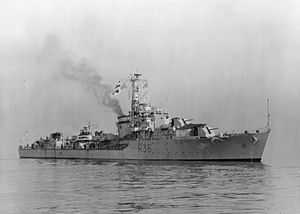HMS Chieftain (R36)
 HMS Chieftain on the River Clyde, 1 March 1946. | |
| Career (United Kingdom) | |
|---|---|
| Name: | HMS Chieftain |
| Ordered: | 24 Jul 1942 |
| Builder: | Scotts Shipbuilding and Engineering Company, (Greenock, Scotland) |
| Laid down: | 27 Jun 1943 |
| Launched: | 26 Feb 1945 |
| Commissioned: | 7 Mar 1946 |
| Identification: | Pennant number: R36 later changed to D36 |
| Fate: | Scrapped at Sunderland on 20 Mar 1961 |
| General characteristics | |
| Type: | Destroyer |
| Displacement: | 1710 tons[1] |
| Length: | 362.75 ft[2] |
| Beam: | 35.66 ft[3] |
| Draught: | 10 ft (mean), 16 ft. (max.)[4] |
| Installed power: | 40,000hp |
| Propulsion: | Parsons geared turbines, 2 shafts; 2 Admiralty 3-drum type boilers[5] |
| Speed: | 36 kts |
| Complement: | 186 |
| Armament: |
|
HMS Chieftain (R36) was a Ch class destroyer of the Royal Navy that was in service from March 1946, and which was scrapped in 1961.
Construction
The Royal Navy ordered HMS Chieftain on 24 July 1942, one of eight Ch class "Intermediate" destroyers of the 1942 Programme. She was laid down at Scotts Shipbuilding and Engineering Company, Greenock, Scotland, on 27 June 1943, and launched 26 February 1945.[6] She was commissioned on 7 March 1946, too late for World War II duty.[7] The yard also built her sister ship, HMS Chequers.
Service
Chieftain was assigned to the 1st Destroyer Squadron based at Malta and saw service, along with other Royal Navy ships, in preventing illegal immigration into Palestine in 1947.[8] She was given an interim modernization in 1954, which saw her 'X' turret at the rear of the ship replaced by two Squid Anti-submarine mortars.[9] She saw duty during the Suez Crisis in 1956.[10]
Decommissioning and disposal
Chieftain was decommissioned after the Suez Crisis and was scrapped in Sunderland on 20 March 1961.[11]
References
- ↑ "Jane's Fighting Ships of World War II 1946/7", Jane's Publishing Company, London, UK, 1946, reprinted by Crescent Books, Avenel, New Jersey, USA, 1995, ISBN 0-517-67963-9, page 52.
- ↑ "Jane's Fighting Ships of World War II 1946/7", Jane's Publishing Company, London, UK, 1946, reprinted by Crescent Books, Avenel, New Jersey, USA, 1995, ISBN 0-517-67963-9, page 52.
- ↑ "Jane's Fighting Ships of World War II 1946/7", Jane's Publishing Company, London, UK, 1946, reprinted by Crescent Books, Avenel, New Jersey, USA, 1995, ISBN 0-517-67963-9, page 52.
- ↑ "Jane's Fighting Ships of World War II 1946/7", Jane's Publishing Company, London, UK, 1946, reprinted by Crescent Books, Avenel, New Jersey, USA, 1995, ISBN 0-517-67963-9, page 52.
- ↑ "Jane's Fighting Ships of World War II 1946/7", Jane's Publishing Company, London, UK, 1946, reprinted by Crescent Books, Avenel, New Jersey, USA, 1995, ISBN 0-517-67963-9, page 52.
- ↑ "Jane's Fighting Ships of World War II 1946/7", Jane's Publishing Company, London, UK, 1946, reprinted by Crescent Books, Avenel, New Jersey, USA, 1995, ISBN 0-517-67963-9, page 52.
- ↑ http://uboat.net/allies/warships/ship/12621.html
- ↑ Stewart, Ninian, The Royal Navy and the Palestine Patrol, Routledge, 2002.
- ↑ Marriott, Leo, Royal Navy Destroyers Since 1945. Ian Allen Ltd, 1989. p.64
- ↑ http://britains-smallwars.com/suez/untis.html
- ↑ Critchley, Mike, "British Warships Since 1945: Part 3: Destroyers", Maritime Books: Liskeard, UK, 1982. ISBN 0-9506323-9-2, page 98.
Publications
- Colledge, J. J.; Warlow, Ben (2006) [1969]. Ships of the Royal Navy: The Complete Record of all Fighting Ships of the Royal Navy (Rev. ed.). London: Chatham Publishing. ISBN 978-1-86176-281-8. OCLC 67375475.
- Marriott, Leo, Royal Navy Destroyers Since 1945. Ian Allen Ltd, 1989. ISBN 0 7110 1817 0
| ||||||||||||||||||||||||||||||||||||||||||||||